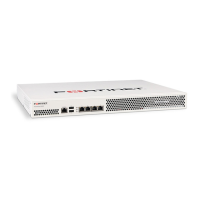Fortinet Technologies Inc. Page 11 FortiVoice 200D/200D-T v2.0 MR1 CLI Reference
Fortinet documentation uses the following conventions to describe valid command syntax.
Terminology
Each command line consists of a command word that is usually followed by words for the
configuration data or other specific item that the command uses or affects:
get system admin
To describe the function of each word in the command line, especially if that nature has
changed between firmware versions, Fortinet uses terms with the following definitions.
Figure 1: Command syntax terminology
• command — A word that begins the command line and indicates an action that the
FortiVoice unit should perform on a part of the configuration or host on the network, such as
config or execute. Together with other words, such as fields or values, that end when you
press the Enter key, it forms a command line.
Valid command lines must be unambiguous if abbreviated. (See “Command abbreviation”
on page 19.) Optional words or other command line permutations are indicated by syntax
notation. (See “Notation” on page 12.)
• sub-command — A kind of command that is available only when nested within the scope of
another command. After entering a command, its applicable sub-commands are available to
you until you exit the scope of the command, or until you descend an additional level into
another sub-command. Indentation is used to indicate levels of nested commands. (See
“Indentation” on page 12.)
Not all top-level commands have sub-commands. Available sub-commands vary by their
containing scope. (See “Sub-commands” on page 14.)
• object — A part of the configuration that contains tables and/or fields. Valid command lines
must be specific enough to indicate an individual object.
• table — A set of fields that is one of possibly multiple similar sets which each have a name
or number, such as an administrator account, policy, or network interface. These named or
Option
Value
Field
Command Subcommand
Table
set ip <interface_ipv4mask>
config system interface
edit <port_name>
set status {up | down}
next
end
Object
This guide is organized alphabetically by object for the config command, and by the name
of the command for remaining top-level commands.

